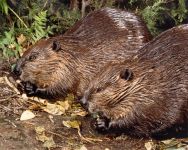


|

|
|
 
|
A small glimpse of autumn has arrived, at least for the moment, giving us a taste of things to come. Like most of the east coast, we are suffering from too much and too frequent precipitation, but these days are finally crisp, clear and sometimes chilly. I have lit several small, cozy fires in the evening to ward off the chill, only to throw the windows wide in the morning to let in the warm, fresh air.
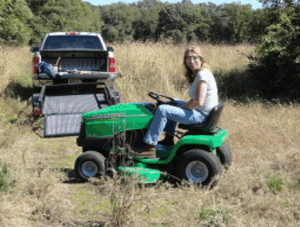
We had a great surprise in September; Jon, a friend from northern New Jersey, heard our plea for a riding mower and donated to us with a brand new John Deere, complete with plow! It was delivered right to our door through a network of angels, and its maiden voyage was into Bluebird Field last week with our newest volunteer, Xenia Christine, at the wheel. While she was mowing, I finished off the last of the trail clearing from Station 9 to Station 10 with my trusty weed whacker.
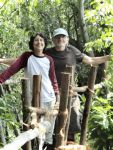
Thanks also to Dennis, Jan, Al, Moe, Frank and Manny for helping with general trail work and preparation for the new deer fence installation. We received a grant to install a the fence around a controversial field where hunters bait deer right next to the Refuge. Hopefully, the fence will prevent the deer from leaving our land to visit the dangerous and deadly treats next door. It will certainly impede anyone from coming into the Refuge with less than moral intentions. Bill and Thea came down in August, and we spent two days installing new handrails across the Dike Boardwalk. The concrete boards need some serious attention, but due to the extremely high water level this year, all we could handle were the handrails. Even so, the Dike crossing is now much more safe and so much more stable. And we had a ball doing it; wow, did we get dirty!
As is our routine, Karen came down during the hot, humid buggy days of summer to help me put up the firewood. Nels chipped in as well, and although we literally finished off the poor old wood splitter, we took care 95% of the logs lying about before it went. The wood was all stacked in the barn for winter, even as the old General sputtered its last wheezing gasp. That log splitter was donated to the Refuge 11 years ago, and produced countless cords of firewood over the last decade; I would say we got our "money's worth" out of it.
I must admit, the trails look absolutely beautiful, trimmed to perfection and ready for fall visitors, photographers, autumn worshippers and patrollers. We are patrolling for bow-hunting season right now, and will continue to patrol until the end of January. Six-day shotgun season runs from Monday, December 5th until Saturday, December 10th. I hope you can join us for some food, fun and friends at some point during that window of opportunity.
There are a few more anniversary remembrances in this issue, and as you read them, you'll see that some supporters have been with us since the very beginning. Thanks to all of you who have contributed your memories, and thanks to you for renewing your membership. And a special thanks to those of you who could give that little extra. It has been difficult for non-profits these past few years, and any donation is so very appreciated and so very dear. I have said it before, and I will say it again: We could not continue without your support.
I had an interesting encounter on the trails this summer. When trail clearing, sometimes my tool is a push mower, depending upon conditions. I gas up and push, pull or hoist it over the grassy and wooded path until I run out of gas. Then, depending on how I feel, I either fill up the tank and do it again, or I cover the lawn mower with a tarp and call it a day. As I work my way through the ten mile spider web of trails, I eventually come back to my starting point, and then we are all set for fall hiking.
On this particular day, I felt energized as I left the cooling, empty mower and retraced my steps to the gas can and big blue tarp where I began. Thankful for the quiet after the roar of the little engine, I daydreamed as I walked back through the sun dappled forest. It was about one o'clock on an August afternoon, and the day was very pleasantly warm.
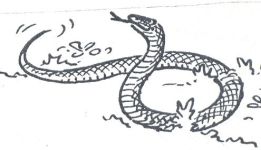
I came across her suddenly, and, as always when I stumble across a snake unexpectedly, I jumped, my heart skipping a beat. She was long and young and sleek. Lean and stretched out her full four feet, she was black on top and milky white on her belly. She tasted the air with her tongue. She looked like she hadn't eaten for awhile, and I could see the hard definition of all her sinewy muscles. She was magnificent.
She looked nothing like the snake who used to live under my cabin. That girl came out every spring, lost, looking for a way back into the great outdoors. I would find her wrapped around the toilet pedestal or wound around the ironing board that hangs on the back of the bedroom door, going up, up, up. She was an old soul, with battle scars and a milky blue-white cataract in her left eye. When I found her, I would gently grasp her behind her head with one hand and with the other unwind her from whatever object she possessed. She would reluctantly let go, hastily rearranging herself around my forearms. Outside, I would place her in a sunny spot out of the way. She would always wait until I was gone before making her next move. One day we played out this scene when I had company and created quite a ruckus. Apparently, not everyone appreciates snakes in the house.
The young snake before me flicked her tongue in and out and drew back as I came in for a closer look. Then she quickly folded herself into several "S" shapes, with her head hanging in the center. This arrangement made her resemble a hooded cobra, poised to strike. I wondered, as she postured and threatened like her deadly cousin, how far she could launch if necessary; a foot? three feet? I realized that I was causing her undo stress in defending her territory from me.
I suddenly felt guilty about this confrontation. How much energy does a snake need to hold a third of its body in a vertical position? Probably more than this lean lady had to squander. I picked myself up off the trail and backed away in the direction I had been going – back to work. Watching her over my shoulder, she stayed put, upright, waiting for me to go away – just like my old cabin snake – unwilling to reveal her intentions to me.
I collected the tarp and gas can and started walking back to the mower, the dirty can bumping my leg, the noisy plastic tarp snagging on the bushes and greenbrier. I looked for her on my way back, but she was gone. I wasn't even sure exactly where on the path we had met.
Since we are still celebrating Unexpected Wildlife Refuge's 50th year, I thought I would share some thoughts about my pivotal decision to join Hope in her endeavor to guide and grow this Refuge. She passed away ten years ago last month, and I still remember our long conversations in her dark living room in the evenings. I remember the first time we met. She was very weak, and moments before I was interviewed by the Board, she met me out front – she said she only had three questions for me.
"Can you drive a stick shift?" "Yes." I answered. Her second question. "Can you split firewood?""No, but I can certainly learn." I replied. And her third, with a mischievous smile, "Do you play Scrabble?" "Yes, I do, and I'm very good," my mischievous smile matching hers. "Carry on." she said and sat in her lawn chair in front of her cabin.
She taught me about beavers, through those conversations and through her fabulous "beaver library" which we are constantly improving. She would lend me a book, always making sure that was absolutely clear. She lamented so many books lost to borrowers who forgot that important word – "lend." She did express the hope that the missing book improved them in some way, however.
I met Hope on the first of June, 2000. She was very ill, and did not stray far from her couch. At age 87, she was recovering from a horrible bout of shingles and was in constant pain from the subsequent nerve damage. Her daughter, Nermin, lived with her and they looked after each other to some extent. We all settled into a pattern.
My schedule was full for sure. Having been accepted by the Board of Trustees as her successor at some point in the near future, I was learning everything I could from her about how to run the Refuge. I was working as an environmental scientist at a large local engineering firm. It certainly wasn't my dream job, having been a tree hugging activist and vocal environmental advocate during the Reagan era. Basically, most of my efforts went toward obtaining permits from the NJDEP for the NJDOT to fill in wetlands for roadway improvements. When in college, you get this degree thinking that you are going to change the world, but graduate to the reality that most jobs available are in the private sector on the "other side."
My typical day, after becoming Hope's right hand, was hectic for sure. I would get up in the morning and walk my dog, Lucy, go to work. At lunch, I would come home and walk Lucy. Again, after work I went home, changed into my other "work clothes," ate dinner and walked Lucy. Then off to the Refuge where I would execute a list of chores for Hope until dark. After dark, she and I would play a game of Scrabble, talk and then I would go home to bed only to get up the next day and do it again.
By September, the days were getting shorter, and I was exhausted. I was preparing to move to the Miller House at the Refuge, which would make things a little easier, but I was still basically doing two jobs; one I loved, the other I liked less and less (except for the paycheck!).
One evening, I was sitting on the Long Boardwalk with Helga, a member of the Board. We were talking about this situation and going through the pros and cons of each job. It was a still, quiet evening with summer winding down around us. The brown water flowed below us as we sat in front of an old abandoned beaver lodge.
We stopped talking and just observed the quiet moment together, holding our thoughts. From around the lodge remains, a tiny V appeared in the water. The V silently glided toward our spot on the cool concrete. It was the face of a very tiny beaver – the first I had ever seen with my own eyes. It tread water three feet in front of us, gazing at us as we looked at her; I was holding my breath. She then turned and paddled her way back from whence she came. The next day I gave my two weeks notice to my supervisor.
Hope and I worked together for a little more than a year – a year and three weeks – before she died. During that time, she taught me everything she could, and we played 340 games of Scrabble in that cabin. When she held my hand and thanked me for taking the mantle of Beaver Lady from her, she had just trounced me at our last game.
She said, "This is a good place to stop." After I went over the old stained score pad, I discovered that she had won 170 games, and I had won 170 games. A good place indeed.
Carry On!
So let's catch up with the good news! Called to many places by reputation, I am working for the beavers on multiple fronts. From Clearview High School, to Washington Township, to Princeton Township, and beyond; I am passing out Sherri Tippi's fabulous handbook on dealing with beavers, a DVD by Beavers: Wetlands & Wildlife on how to build and install a successful flow device and our literature on why beavers are more beneficial to us alive. We've advised golf courses and home owners and municipalities. After the heinous shooting of two beavers in Princeton Township's conservation area, I have offered my services to Mayor Goerner to assist his administration in creating a long-term, life-saving Beaver management policy for the township. I sent him the aforementioned materials along with a couple issues of this newsletter so he can learn something about our preservation area. I have called to follow up with little luck – we will see what happens, but as you have probably figured out by now, I don't go away easily.
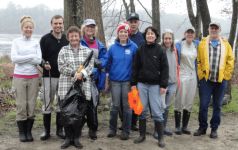
We had a fantastic turnout for the annual Piney Hollow Road Earth Day Clean-up with many new faces showing up to enjoy picking trash and slinging hash. A special thanks to Bill and Thea for our new trash enclosure to keep out our raccoon friends. The annual Frog Walk with Froggy Fred Akers and his wife Julie was also a hit. We were lucky to have four youngsters out in the woods with us that night – something of a rarity these days. Even though the frogs were a little quiet this year, I think everyone had a wonderful and unique experience. A bonus for me was to see Claire and Rob, two great Beaver Defenders from Virginia – I met them here just days after getting this job 11 years ago.
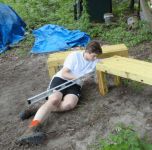
Congratulations to Jared Novak, our 9th Boy Scout to complete his Eagle Scout Leadership Project here. Jared, who is in Troop 65, Haddonfield, constructed a Beaver Viewing Platform next to the Main Pond. Jared creatively overcame unexpected challenges to reach his goal. We now have an easily accessible and comfortable spot next to the pond to watch our furry friends on the water.
Speaking of beavers, Mom has given birth to this year's kittens. She is out briefly in the evening to take a break from her motherly duties and have an apple snack. The yearlings are all still here and fine, and Dad still does not like me. I hope to see the new babies soon; it is like no other experience to see a tiny new beaver kitten. It will make you hold your breath, and it may even make you quit your job.
In March, Jean and Nels came by in the afternoon for some bluebird fun. While Jean and I cleaned the boxes in Bluebird Field, Nels made repairs to all the boxes in the Codario fields. We had a lovely chilly day looking inside the homes of many different kinds of birds – bluebirds, chickadees, tree swallows – they all have their own signature nests. Some like needles, some fur or feathers, and some moss. Nels reported that half a dozen of the bluebird boxes in the fields were taken by bluebirds at some point since putting them up. After we were done with our chores, we stood in the field alert for any interesting movement or songs, knowing our birds would be scouting nice clean safe nest sites.
The following week, one of my regular volunteers who will remain nameless, enthusiastically came forward for the unsavory task of making a poop run. I find poop runs to be fun, but then that's just me. We take the truck loaded with empty buckets and head for Helga Tacreiter's Cow Sanctuary in Shiloh, NJ. It was a sunny but chilly day; a lovely ride through some of the most pleasing scenery in Southern New Jersey with rolling farm fields and forests. Helga met us there, with dogs, emus, goats and geese running about. We also got to meet Helga's latest residents, a herd of beautiful boys who were spared from the usual fate of male cows in the dairy industry. They stood around and watched us pick up their deposits and occasionally pushed in for a head scratch. Like all of Helga's cows, when they get to the Sanctuary, they retire to a life of cow leisure. When we finished filling a dozen pails with cow contributions, we got to meet Patrick the three-legged pig. We fed him bread which he took with a great deal of grace and gentle dignity. Then it was back to the Refuge Butterfly Garden with our golden dung.
Al stopped by for a chainsaw day last week. We set out at 10 with two fueled up saws, wedges, hammer and a hankering for cutting up downed trees. I drove us down the trail in the pickup as far as we could go, scraping through the mountain laurel, refreshing our poor Chevy's Piney pinstriping. Normally, I would not drive to the trailhead, preferring to walk, but carrying two chainsaws, backpack and headgear is hard enough. Any eliminated footwork under these circumstances is always totally worth it.
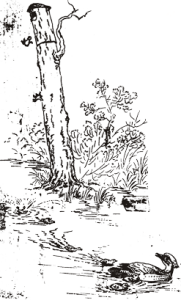
Al, who I think is a creative genius in his own right, tried to rig up a chainsaw backpack out of a canvas guitar case, which worked fine in theory. Unfortunately, the zipper was the weak link, and we both ended up carrying our saws like deranged luggage, twisting our wrists to accommodate the angle of the handle, bumping the saw against our legs. Our goal was to clean up all the blow downs on Main Trail. Main Trail is one of my favorite walks. It follows the swamp that turns into part of the stream that flows through the heart of the Refuge. One must-see stop on Main Trail is Otter Dam. Hope, our founder, named it Otter Dam because one morning many, many years ago she came upon a beaver dam there with a pile of otters sleeping on top of it. Now there is no dam and no sleeping otters. There is however, a wooden platform constructed over flowing water. Wood ducks, spotted turtles and prothonotary warblers call this oasis home. It is a wonderful place to eat lunch, nap, write or just sit quietly with your thoughts. The dam has been gone for decades, but the otters still pass through on a fairly regular basis.
In the spring, when you walk quietly (very quietly) along this path, you will see wood ducks swimming through the swampy woods. You only get a glance, because they always hear you and explode out of the water and up into the air through the cedar trees, the female sounding the alarming squeal "ooEEK! ooEEk"! Wood ducks and turkeys always startle me when they do that. Woodcocks also spring from the grass, spiraling off in terror, leaving me breathless.
Decades ago, when the water table was much higher, beavers lived back on Main Trail. You can see their ancient tooth work in the older trees along the trail. These trees are quite far from open water, so the hydrology of the land is quite different now; high and dry. But the ground is wet in the spring, so the trees roots are very shallow. This being the case, when the strong winds blow in March, many of the larger trees topple. So Al and I had our work cut out for us – no pun intended. The trail is now cleared of all obstructions and ready for traffic.
For those of you blessed to have visited Unexpected Wildlife Refuge you have seen our old cabin that serves as the headquarters for the organization. The original building, here for decades even before the Buyukmihcis bought the land, was modified and enlarged by Hope and her husband Cavit to accommodate their family.
The condition of the cabin has been steadily deteriorating, especially after the death of Cavit in 1987; he was the "maintenance man" at Unexpected. An inadequately constructed foundation, lack of ventilation and a neglected roof and gutter system have taken their toll; mold, termites and rot have set in.
The Board has discussed removing the existing building and replacing it with a new structure. However, the Board believes that this should not be done lightly in our current global situation.
Sustainability in construction, demolition techniques, energy and water use and recycling are paramount in today's stressed environment. It was decided that Unexpected Wildlife Refuge would embark on a project that will address the environmental and economic consequences of its actions, and also provide the public with an educational resource for life changing information: A Platinum LEED certified Refuge Headquarters.
Through our good friends at Conservation Resources Inc., we have received a grant in the amount of $28,000 for the creation of architectural plans for the new facility. We have met with several firms and have narrowed the selection down. It will take about a year after we launch the project to have the drawings complete for construction.
Now is that good news or what?